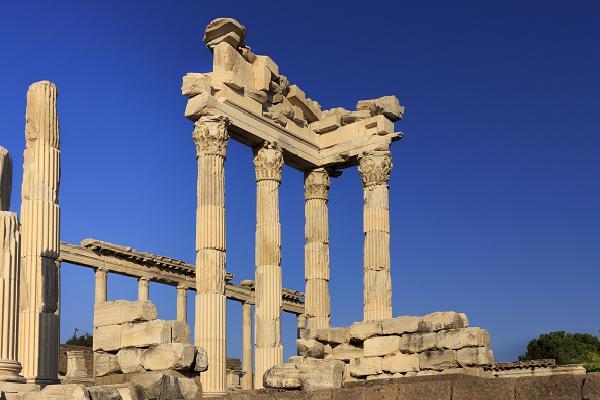Heinrich Schliemann was quite possibly an early version of Donald Trump, German style. On the one hand, he certainly contributed to archeological knowledge and progress; on the other hand, the man was an incorrigible, self-aggrandizing, irresponsible liar.
Schliemann’s Origin
Heinrich (06 January 1822 – 26 December 1890) was born in Neubukow, Mecklenburg-Schwerin, a little more than 30 kilometers south-southwest of Rostock, quite near the Baltic Sea, and died in Naples, Italy. He traveled extensively during his lifetime, driven, perhaps, by his utter boredom with life as he found it and by a relentless desire to excel at something that would raise him from what he deemed the “muck of mediocrity.”

Schliemann’s Inspiration
Over the years, he had many explanations for his interest in archeology. He claimed that, when he was seven, his father, a Lutheran pastor who was later defrocked for having embezzled church funds, had given him a history book showing Troy in flames, probably Ludwig Jerrer’s Illustrated History of the World. Schliemann claimed that the image affected him so much that, for the rest of his life, he believed Homer’s stories from The Iliad and The Odyssey. He also claimed that, when he was eight years old, he vowed to excavate Troy. He also insisted that, after he had begun an apprenticeship under the direction of a grocer in Fürstenberg at the age of 14, he heard a drunk recite passages from Homer’s poems and it was that experience that inflamed his passion for discovering and excavating Troy. As with many charming psychopaths, their stories are tailored for their audience rather than to relate to the truth.
Heinrich Schliemann’s Sense for Business
Despite his chronic deceitfulness, fakery, and downright crookedness, he did have some objectively valuable characteristics, e.g., a true gift for languages. He could easily converse in English, French, Dutch, Spanish, Portuguese, Swedish, Polish, Italian, Greek, Latin, Russian, Arabic, and Turkish as well as German. Schliemann also had a businessman’s knack for getting things done. This skill was particularly valuable after he inherited his brother’s estate in 1850 and parlayed the fortune (more than $1 Million in gold) into marriage with the daughter of a wealthy friend. He further parlayed his increased fortune into cornering the market in important commodities (saltpeter, sulfur, and lead) needed by Russia to prosecute the Crimean War as well as cornering the market in indigo dye. He was a prescient opportunist.
Schliemann’s first Steps as an Archeologist
In 1868, Schliemann positioned himself as a serious archeologist by first excavating a hilltop, Pinarbaşi (also known as Bunarbashi), at the edge of the Trojan plain. This hill was widely assumed by many to be the likely site of Troy; however, Schliemann’s colleague Frank Calvert, a disaffected English national and fervent amateur archeologist, had sought Troy for seven years at the location known as Hisarlik, before he collaborated with Schliemann. Based on Schliemann poaching Calvert’s seven years’ work to identify Hisarlik as the likely site of Troy and by his plagiarizing another author’s notes regarding the area’s topography, the University of Rostock awarded Schliemann a Ph.D. in absentia.
Schliemann’s archeological “Legacy”
Since archeology was more of a passionate endeavor pursued by amateurs rather than a professional and rational science in the mid 19th century, the excavation activities of those enthusiasts were quite ham-handed, even destructive. His sloppy excavation of the site in 1871, which at the time was thought to comprise seven layers of cities (actually, there are 13 main and sub-layers) atop one another, mistook what we know now as Homeric Troy (Troy VIIa) for a later Troy. Schliemann’s overconfidence and self-promotion drove him to make claims that, while reluctantly accepted by many of his contemporaries, proved to be invalid.
That didn’t stop Schliemann from smuggling precious booty, which he nonsensically named Priam’s Treasure, from Turkey to enhance his wealth by selling the artifacts to museums in Berlin. To this day, their authenticity and, in some cases, provenances are deemed questionable. Had Schliemann been left to his own devices, none of his successes at Hisarlik would have come about had it not been for the persistent research and enthusiasm of Frank Calvert, yet Schliemann deliberately neglected to credit Calvert with any significant contribution to the discoveries.
In her book Finding the Walls of Troy: Frank Calvert and Heinrich Schliemann at Hisarlik, Susan Allen included the following in a flyleaf blurb: Schliemann was a “relentlessly self-promoting amateur archaeologist” and subsequent archeologists routinely condemn Schliemann for having destroyed many remnants of the original layers of the real Troy irreparably. Contemporary archaeological experts even go so far at to assert that Schliemann destroyed Troy far more efficiently than the Greeks.
